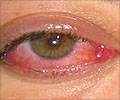A new study from University Hospitals Case Medical Center has revealed the mechanism through which fungus strains cause corneal infections.
A new study from University Hospitals Case Medical Center has revealed the mechanism through which fungus strains cause corneal infections, similar to the ones that compelled ‘Bausch & Lomb’ to withdraw its ReNu with MoistureLoc contact lens solution in 2006.
The researchers have shown that these infections were fuelled and made resistant to treatment by the formation of a highly resistant structure of microbial cells held together with a glue-like matrix material. They call this conglomeration of cells biofilms.“Once they live in that type of state, the cells become resistant to lens solutions and immune to the body’s own defence system. This study should alert contact lens wearers to the importance of proper care for contact lenses to protect against potentially virulent eye infections,” said senior researcher Mahmoud A. Ghannoum, director of the Center for Medical Mycology at University Hospitals Case Medical Center.
“Biofilms are a constellation of resistant organisms,” he added.
This is the first study to provide in-vitro model for cornea keratitis infections caused by a fungus called Candida albicans, and another fungus Fusarium, which was one of the main culprits in the ReNu with Moisture Loc cases.
Dr. Ghannoum says that the study has also revealed that the strain of fungus (ATCC 36031) used for testing the effectiveness of lens care solutions is a strain that does not produce biofilms as the clinical fungal strains do.
Lens care solutions, which are currently tested against an old and rare genotype fungal strain obtained in the 1970s from a patient from Nigeria, are effective in the laboratory, but fail when faced with strains in real-world situations.
Advertisement
“We recommend that solutions be tested for biofilms produced by more recent clinical isolates. One of the underlying reasons for ReNu with MoistureLoc not being effective against the outbreak of keratitis is that the solution is not effective against biofilms and the organisms contained in biofilms,” he added.
Advertisement
Given the commonness of biofilm contamination of contact lens cases, and since ReNu with MoistureLoc is ineffective against fungal biofilm, Dr. Ghannoum says that the industry must ensure that their multipurpose solutions are effective against biofilms.
He also recommends exercising extreme caution to ensure the contact lens care case is not contaminated with biofilm.
Dr. Ghannoum suggests that soft contact lens wearers use only fresh lens care solution, change the solution regularly, and avoid using the solution beyond the expiry date written on the package.
He also recommends a rub and rinse method to clean contact lens, besides ensuring that the bottle caps and tips of multipurpose solutions are clean.
The study has been published in the journal Antimicrobial Agents and Chemotherapy.
Source-ANI
LIN/K






